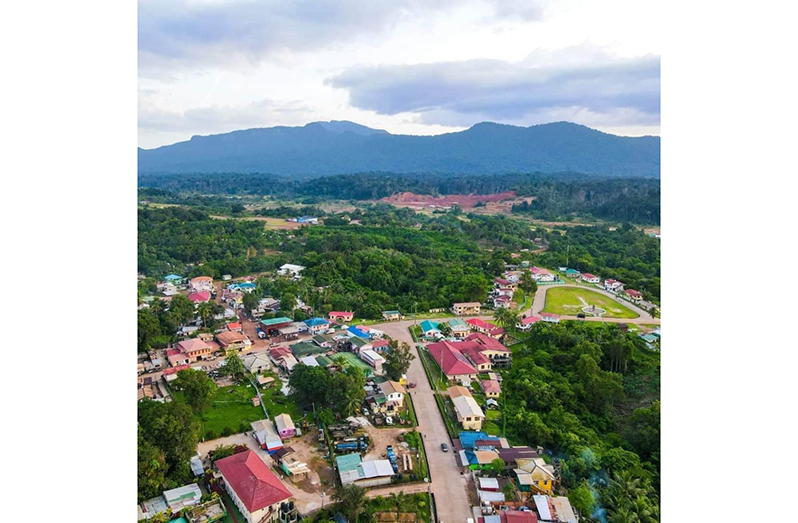DURING his keynote address at the opening of the Guyana embassy in Qatar, the President, Dr Mohamed Irfaan Ali, said: “Guyana is leading on the issue of climate change globally. We are the first country to deploy large-scale carbon on the international market, the first country to sign an end-user agreement with Hess Corporation, and the first country to sign a bilateral agreement on the sale of carbon credits with the Kingdom of Norway. The forest, which is the second-largest forest cover globally, stores 19.5 gigatonnes of carbon. So, as we discuss climate change and environmental services, those discussions cannot be without Guyana as a main player and stakeholder.”
While continuing the work that was pioneered by Vice-President, Dr Bharrat Jagdeo in 2009, President Ali has made it a priority to strengthen Guyana’s climate security since he was elected in 2020. This includes the introduction of the Low Carbon Development Strategy 2030, an expanded version of the LCDS 2009, following consideration of several regional and global developments that centre on investments in clean energy to promote low-carbon growth, defence against climate change, and preservation of biodiversity.
President Ali and his government finalised a sale agreement last December with Hess Corporation. Hess will buy high-quality carbon credits directly from the government for at least US$750M between 2022 and 2032.
The agreement will contribute to advancing low-carbon development in Guyana, support the maintenance of the vast forest that covers 85 per cent of Guyana’s landmass, and provide financing for programmes that would enhance the lives of villages and communities across the country.
In addition, Guyana has taken a proactive role in a number of international initiatives and accords addressing climate change.
The nation took part in the United Nations Framework talks and made a significant contribution to the cause of improving climate resilience. The country continues to uphold its commitment to safeguarding and preserving wildlife and biodiversity, and it participates in the global programme known as “30 by 30,” which calls on governments to protect 30 per cent of their land and ocean regions by the year 2030.
 Recently, a group of youth leaders and young professionals from over 30 nations gathered in Casablanca, Morocco, to discuss and create neighbourhood-based solutions for global concerns. The Global Youth Convention (GYC) 2023, which was hosted by the Headway Institute of Strategic Alliance (HISA), gave a lot of attention to energy and climate change this year.
Recently, a group of youth leaders and young professionals from over 30 nations gathered in Casablanca, Morocco, to discuss and create neighbourhood-based solutions for global concerns. The Global Youth Convention (GYC) 2023, which was hosted by the Headway Institute of Strategic Alliance (HISA), gave a lot of attention to energy and climate change this year.
Guyana’s Low Carbon Development Strategy (LCDS) 2030 was significant among the topics of interest. Ravin Singh, the Director of Projects and Policy at the Office of the First Lady in Guyana and a member of the neighbourhood non-governmental organization (NGO) Guyana Environment Initiative (GEI), was Guyana’s representative at the event.
On the first day of the conference, Singh highlighted in his presentation that Guyana’s LCDS 2030 is a strategy that outlines how the nation will advance economic growth and development in a non-polluting, low-carbon manner. He also emphasised that the policy strongly emphasises the environmentally responsible management of Guyana’s forests, which are crucial for ecosystem services and carbon storage.
According to him, the LCDS 2030 measures for reducing and adapting to climate change effects were also mentioned, emphasising infrastructure, agriculture, and health.
In response to President Irfaan Ali’s recent remarks in Qatar, in which he posited that Guyana is leading the world in combatting climate change, Singh said that Guyana’s story is an exemplary case of low-carbon development in action and an example that other countries can emulate.
“It was therefore important for me to tell our story and let our environmental credentials be known to youth leaders who are influencing policies around the globe,” he noted.
The youth delegate also referred to the historic multi-year deal between Guyana and Hess Corporation to sell carbon credits. Since many nations have yet to be able to benefit from the provision of carbon services, Singh stated that the sale of carbon credits was an area in which many of the delegates were interested. He explained that with the second-largest forest cover in the world, Guyana’s forest holds 19.5 gigatonnes of carbon.
About this, he explained that Guyana would maintain its net carbon sink status as it advances development in its oil and gas sector.
The attendees were also made aware of Guyana’s goals and continuing initiatives to create a mix of energy sources focusing on solar, wind, hydro, and natural gas.
The GYC connects youth leaders and young professionals with business leaders and officials worldwide to encourage and promote community-based solutions on a local, regional, and global scale. It also offers a forum for policy creation and reform.
(This is part of a weekly series on LCDS.) The author can be contacted at cparkinson0206@gmail.com.)



.jpg)








